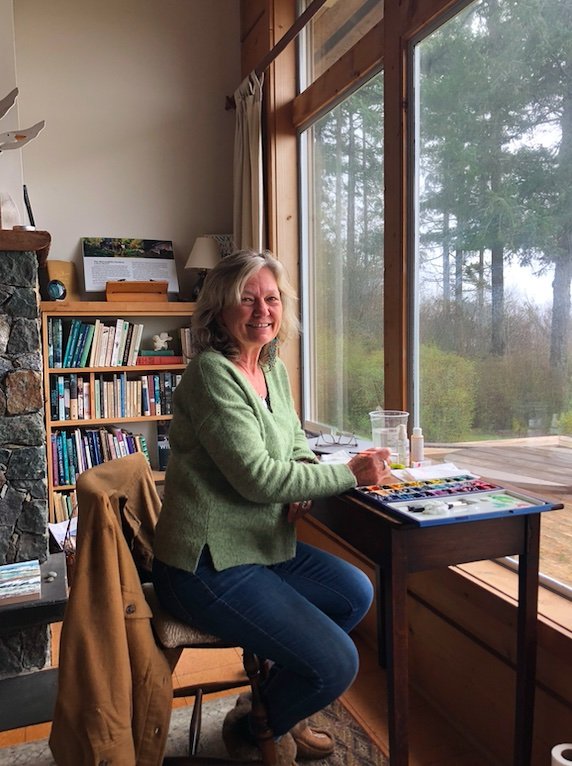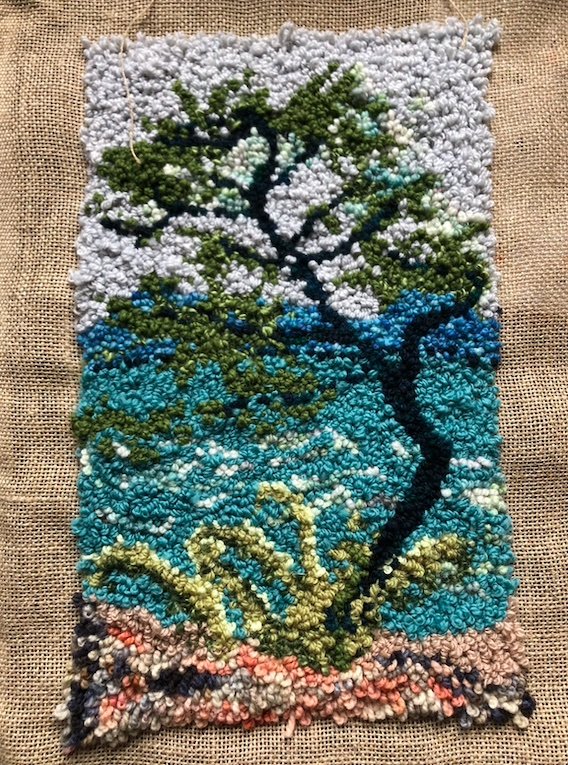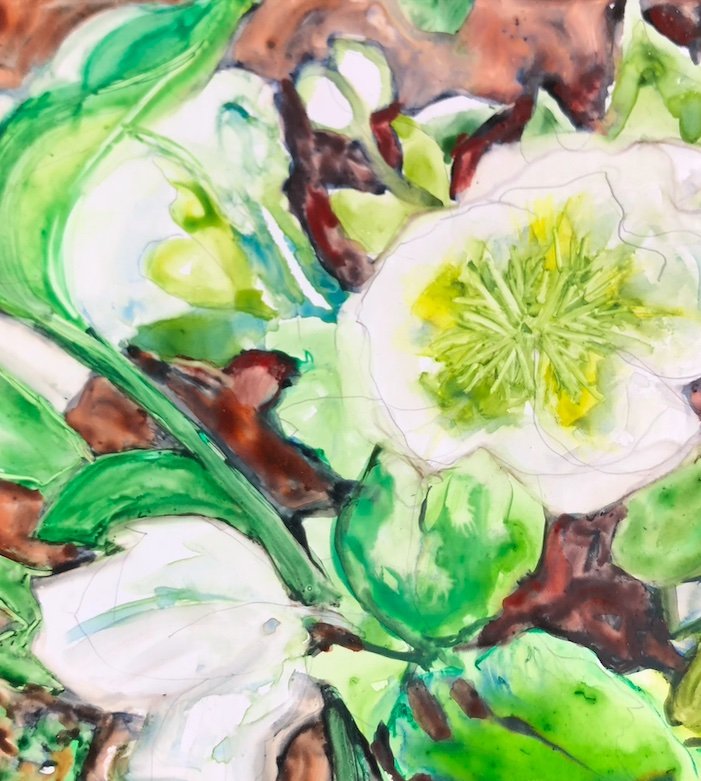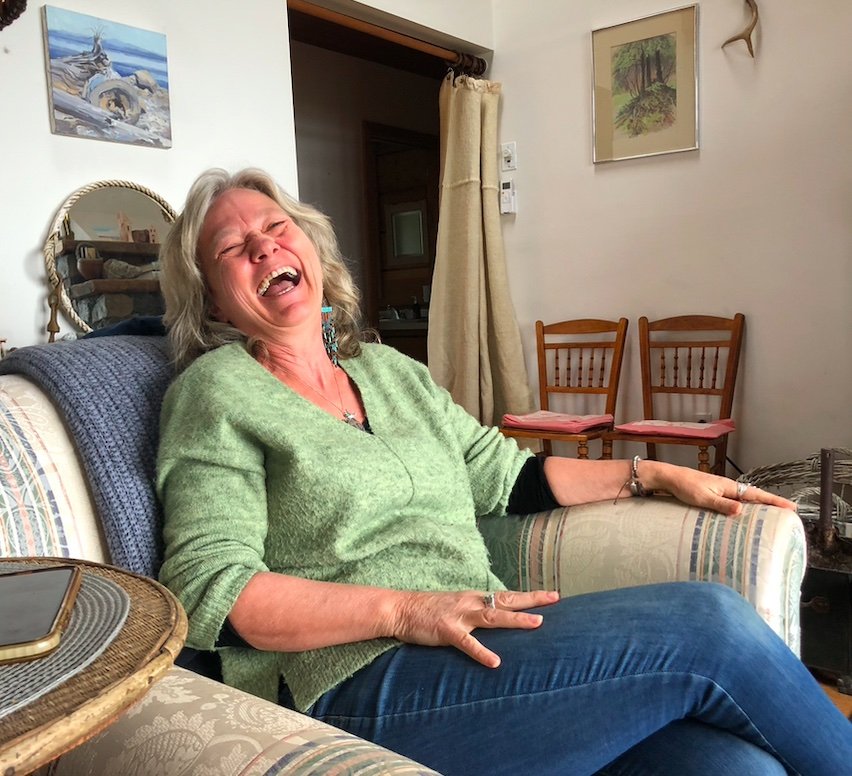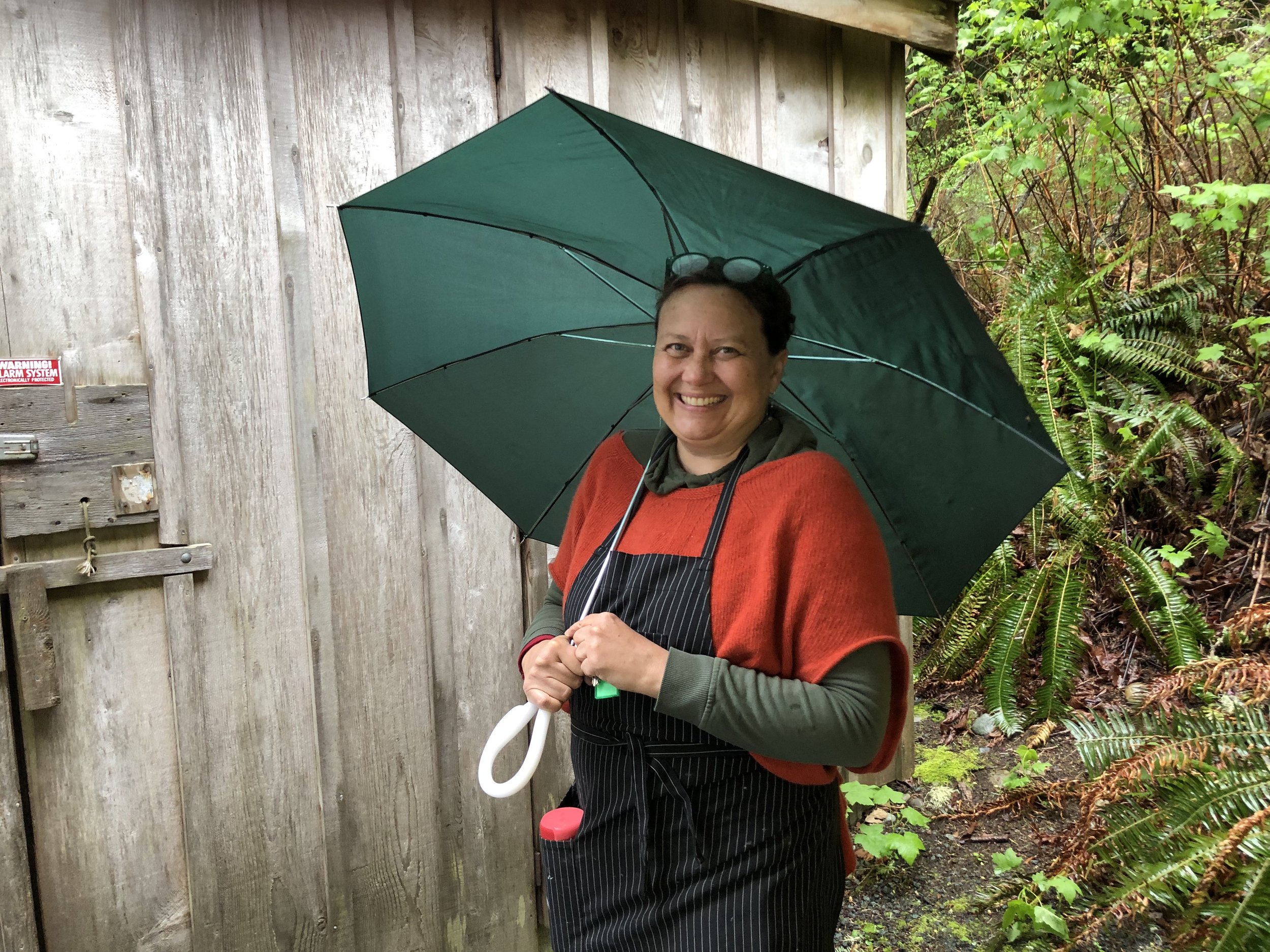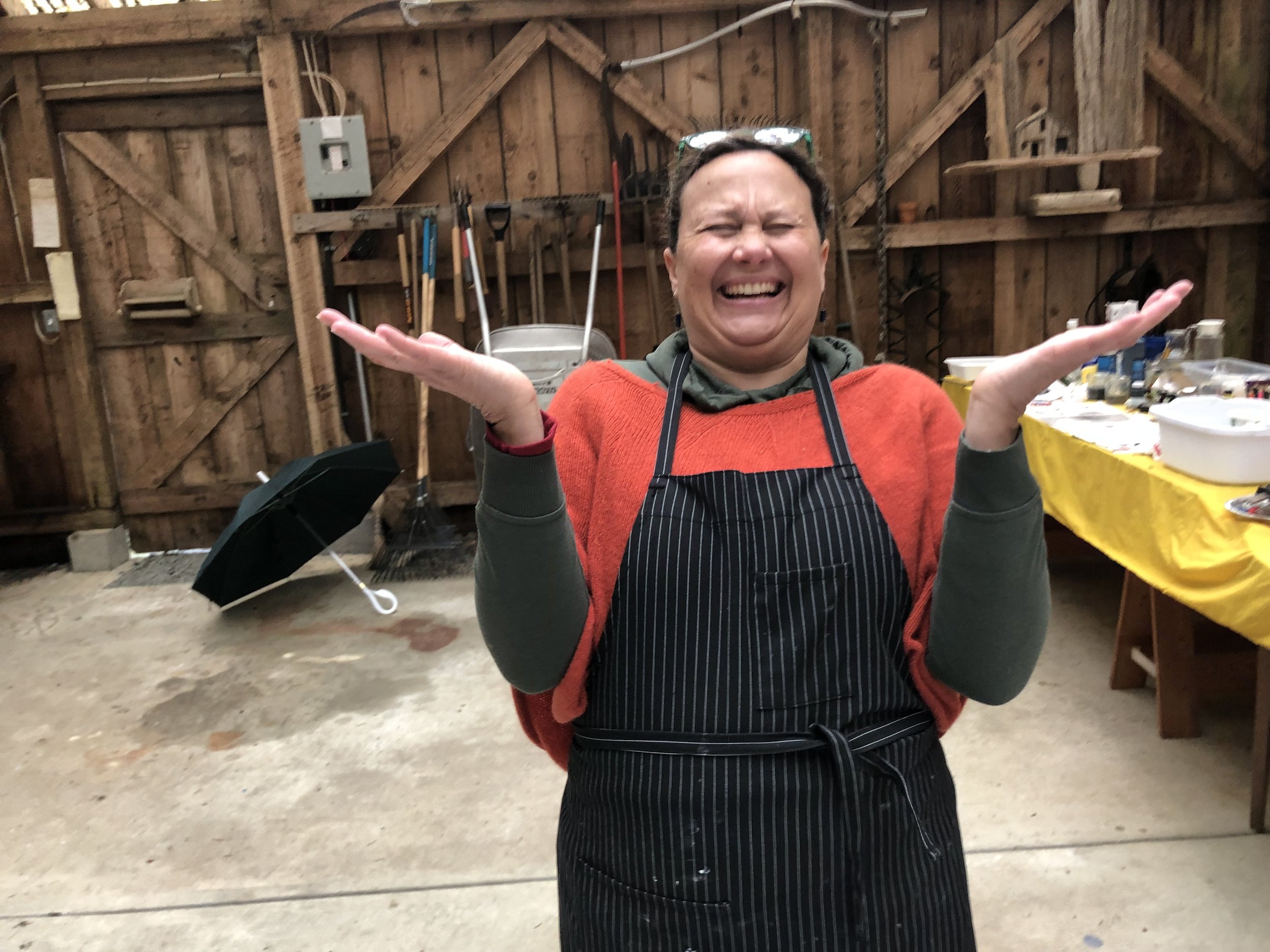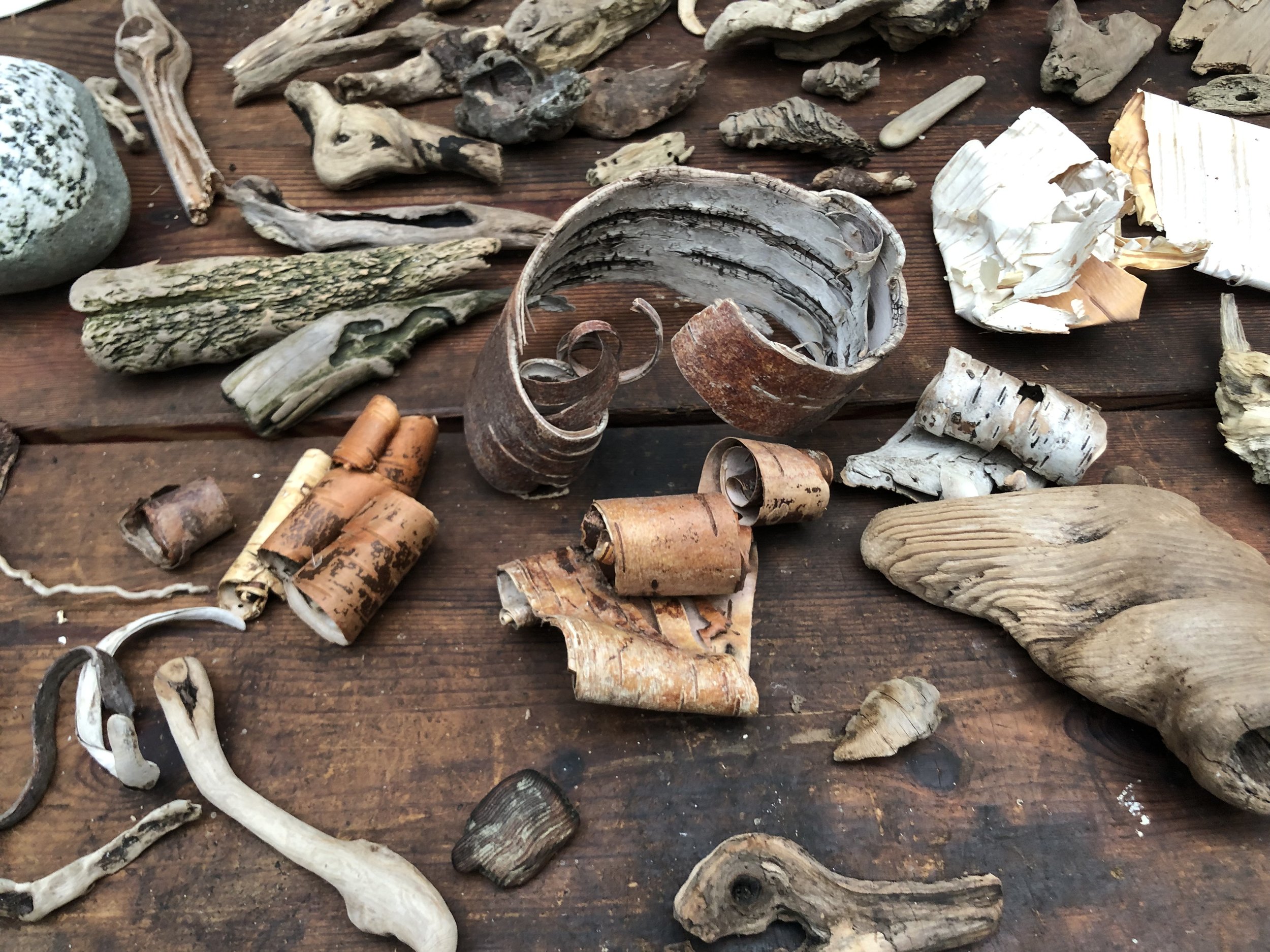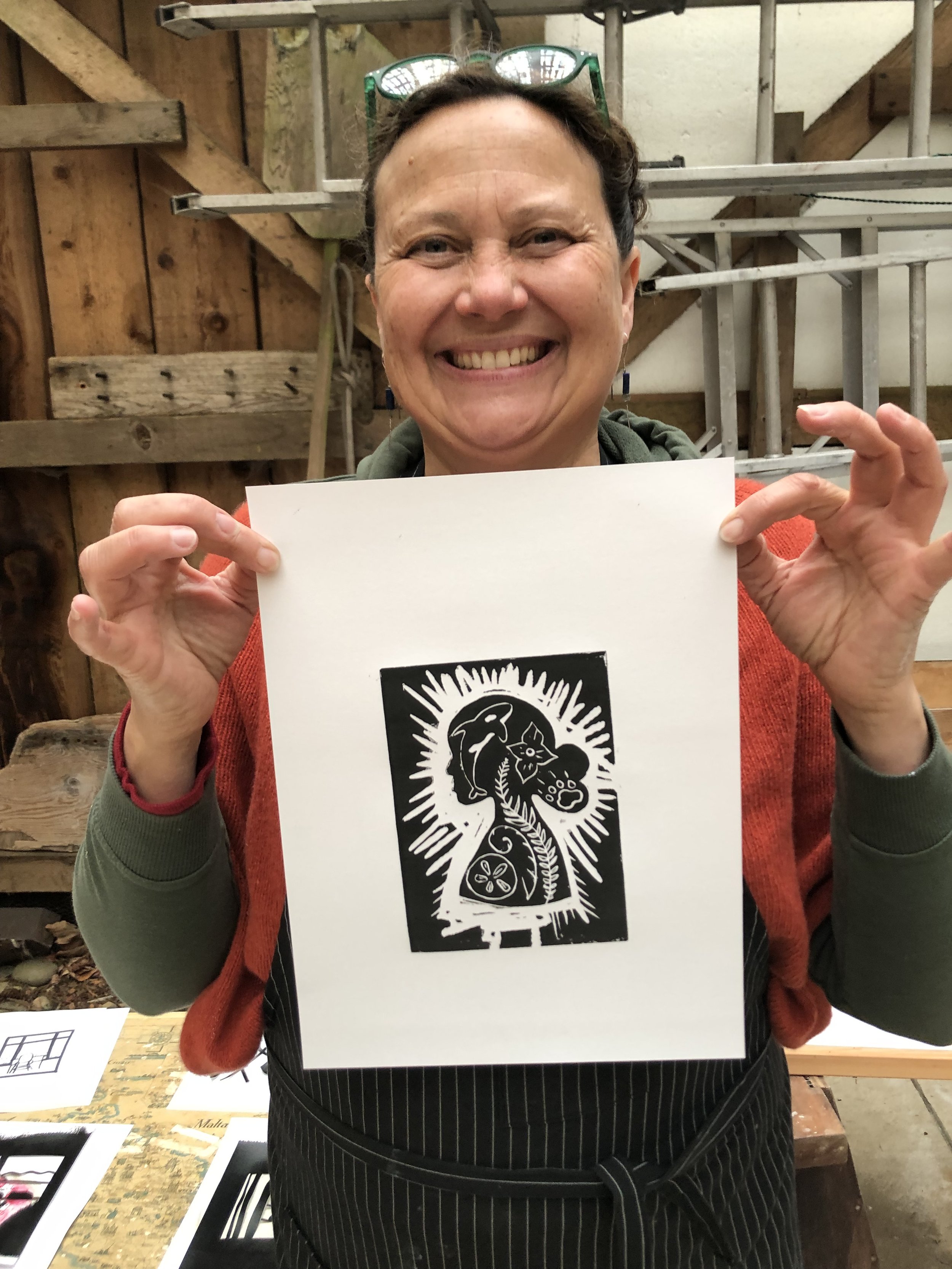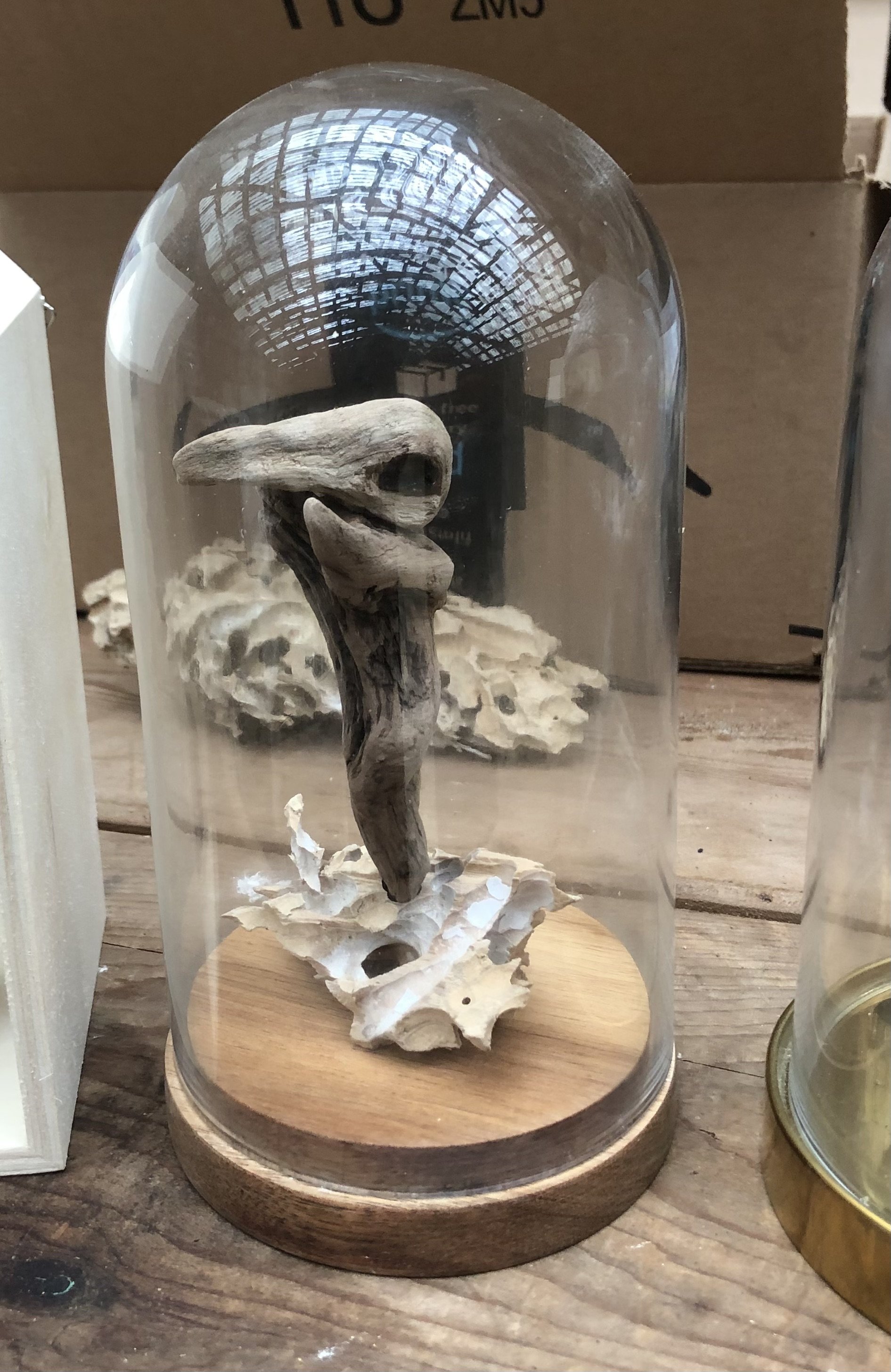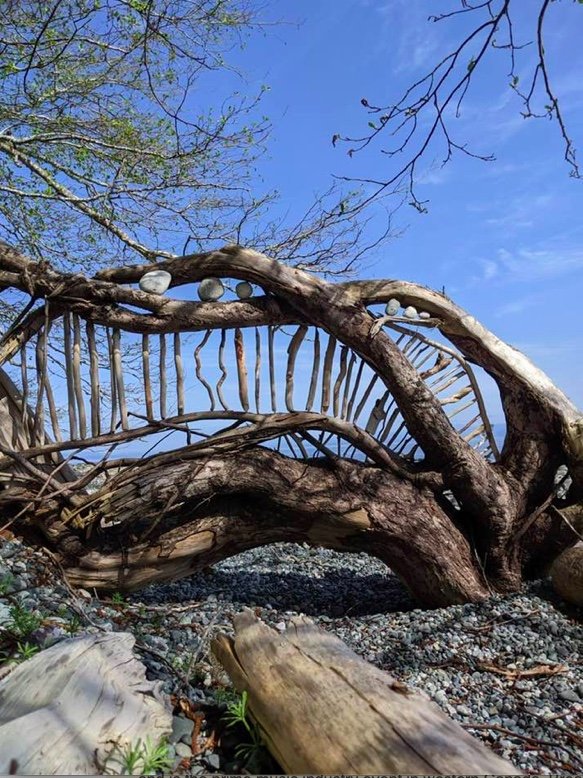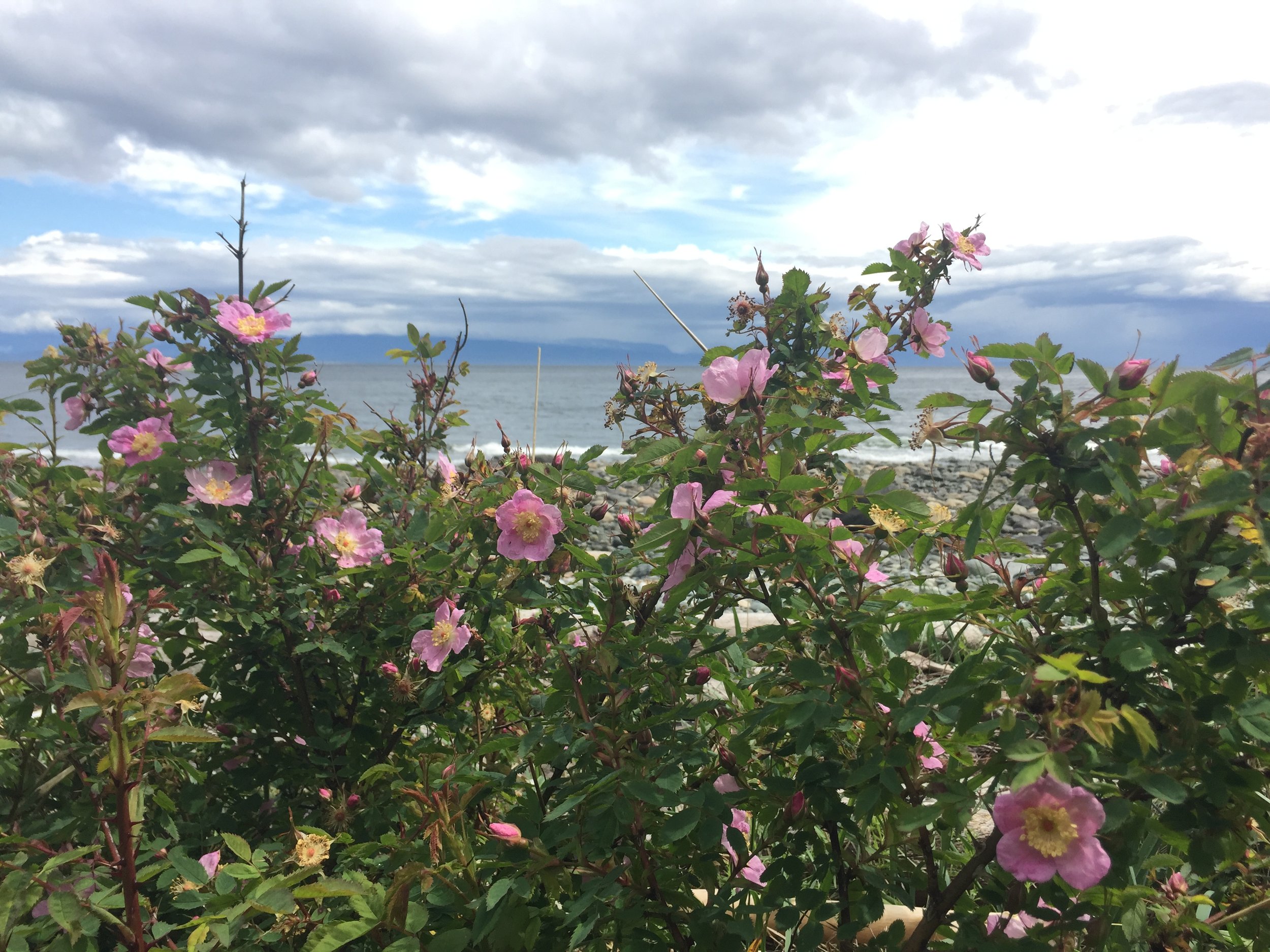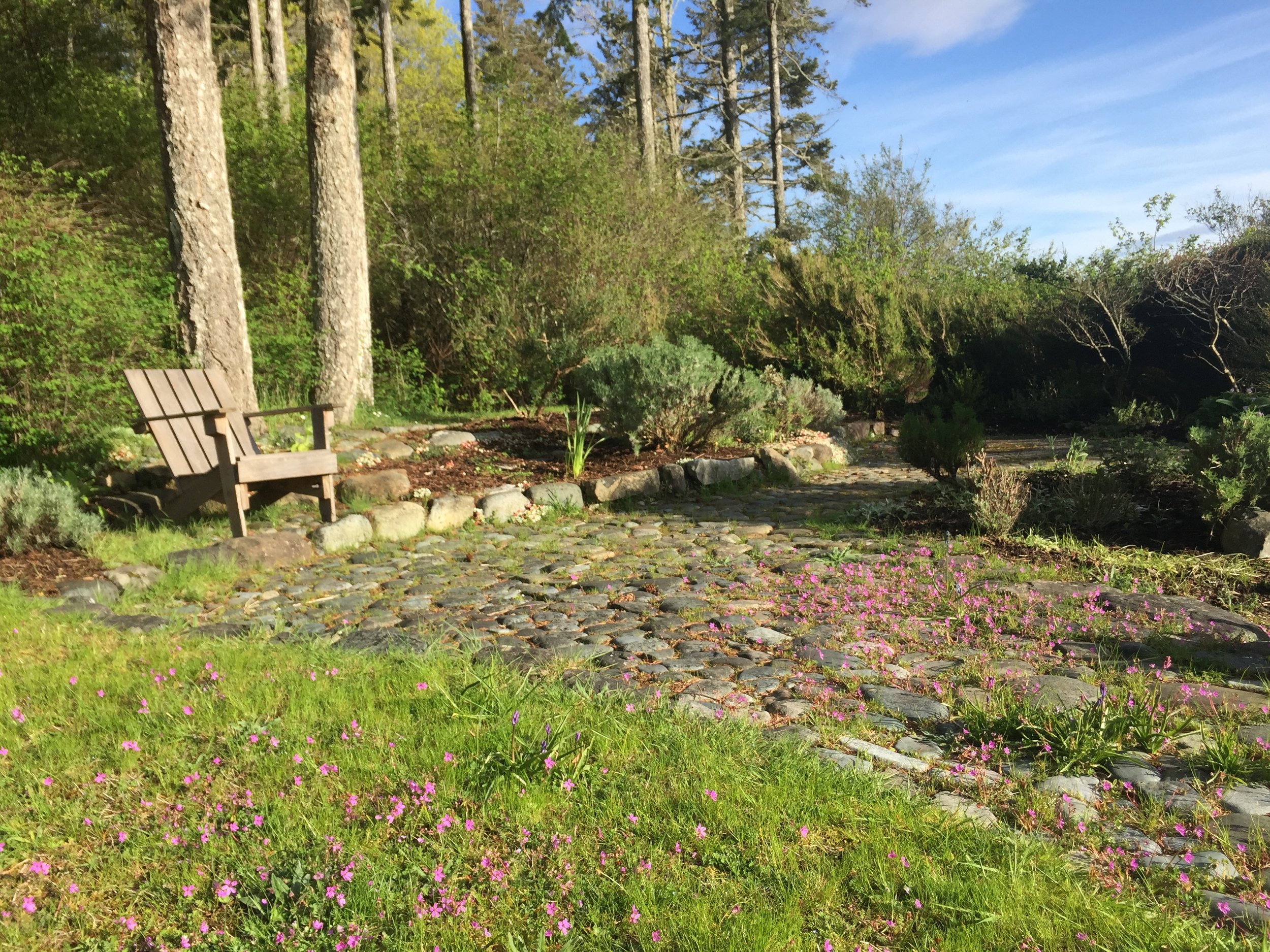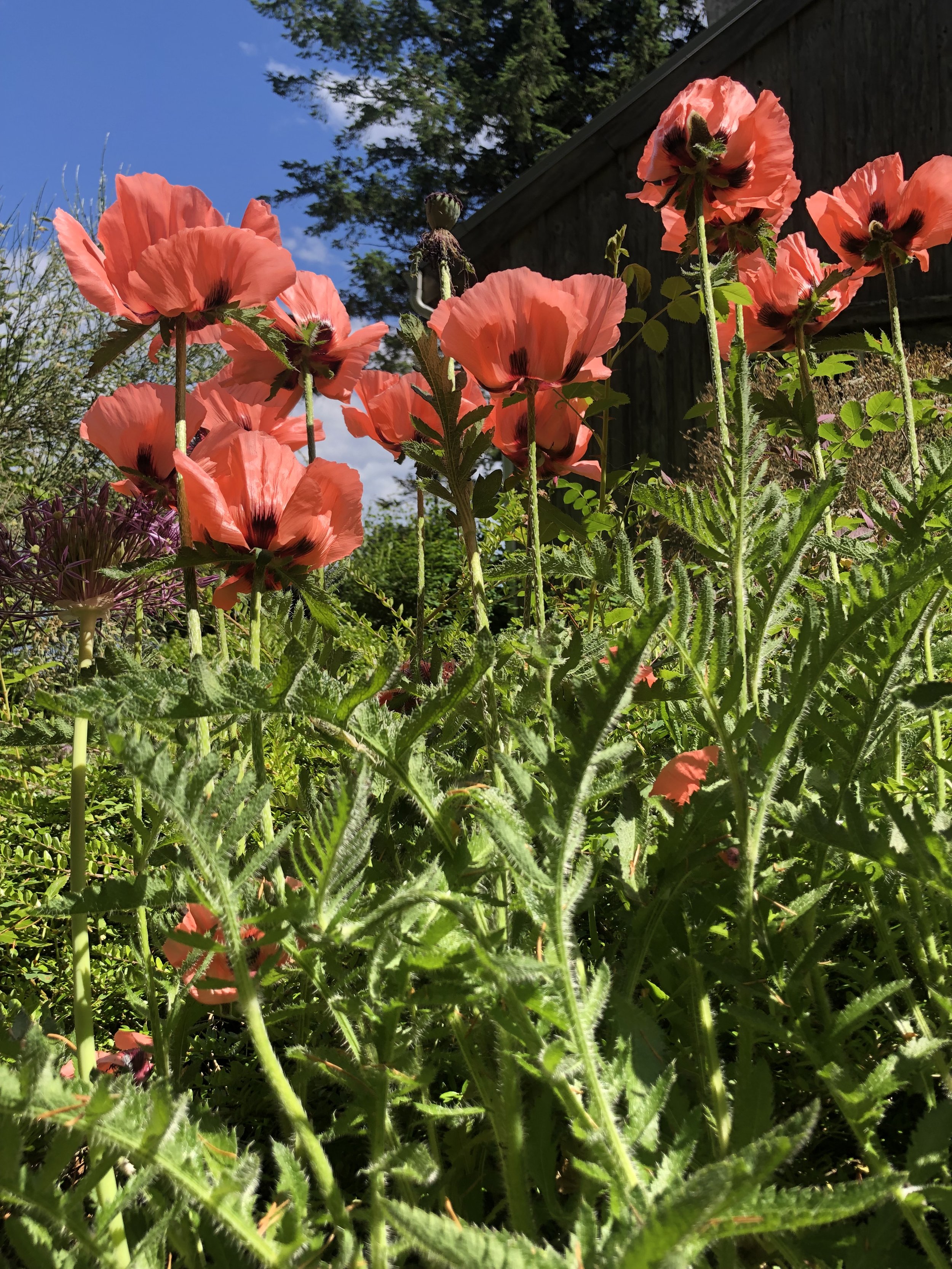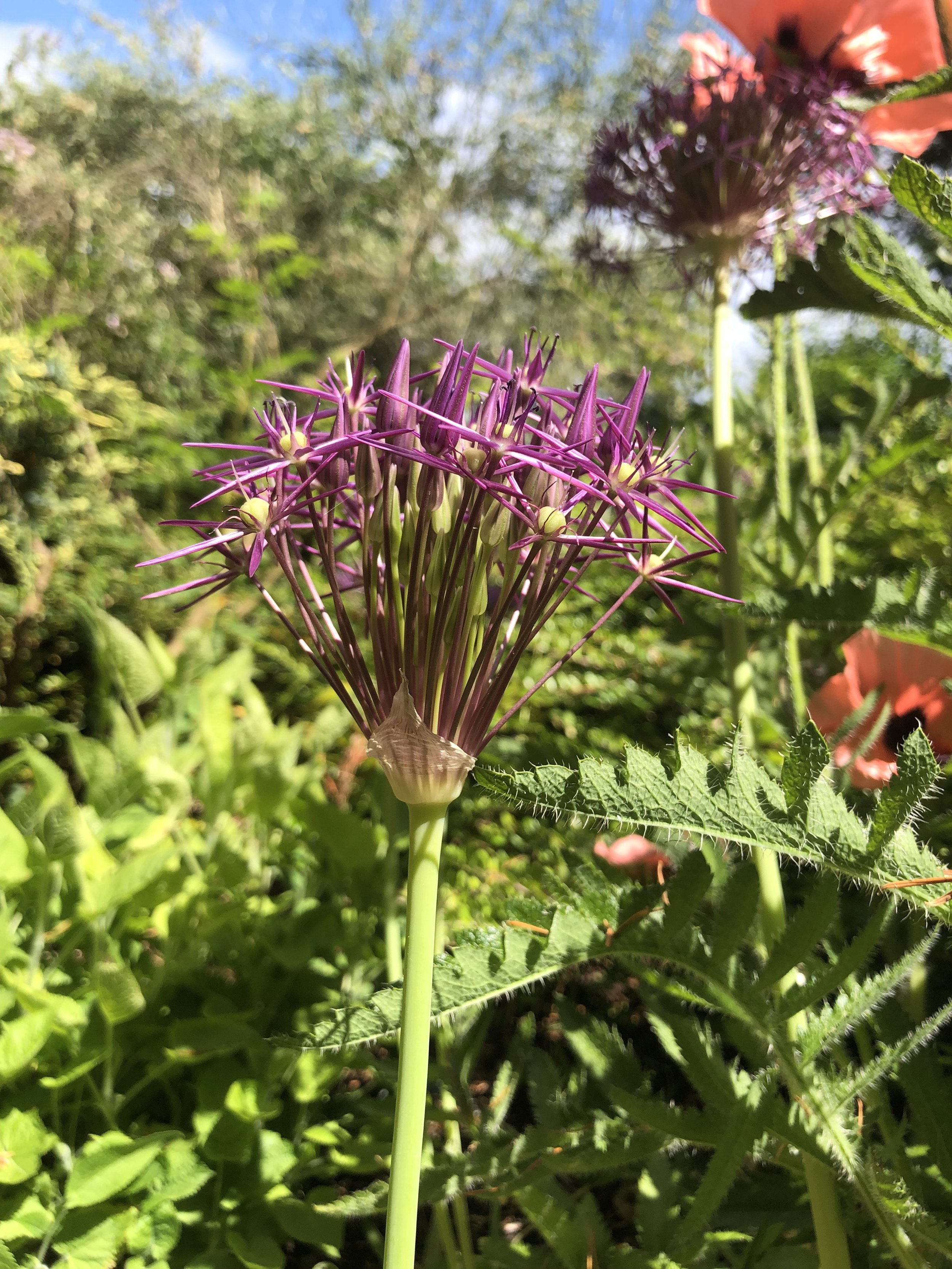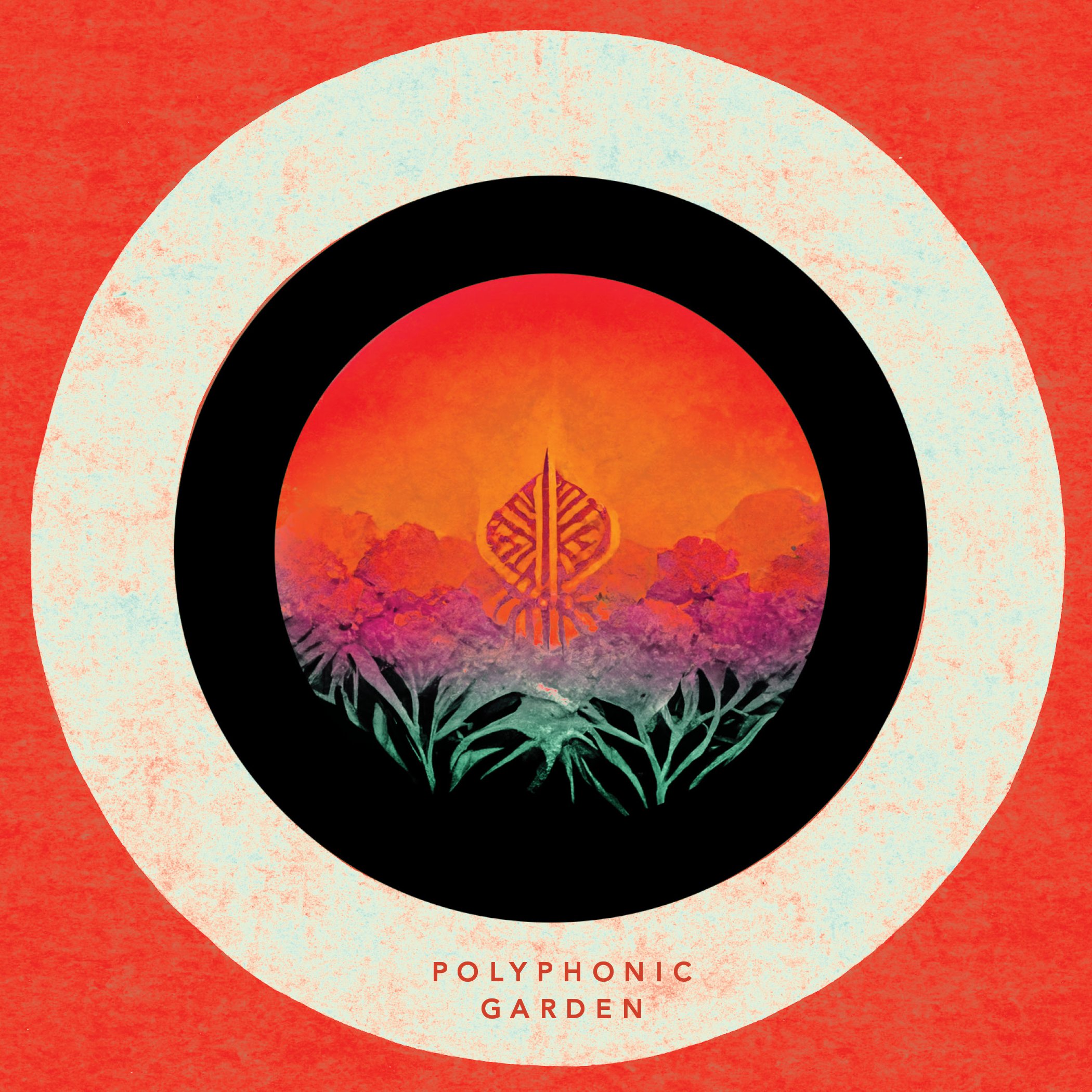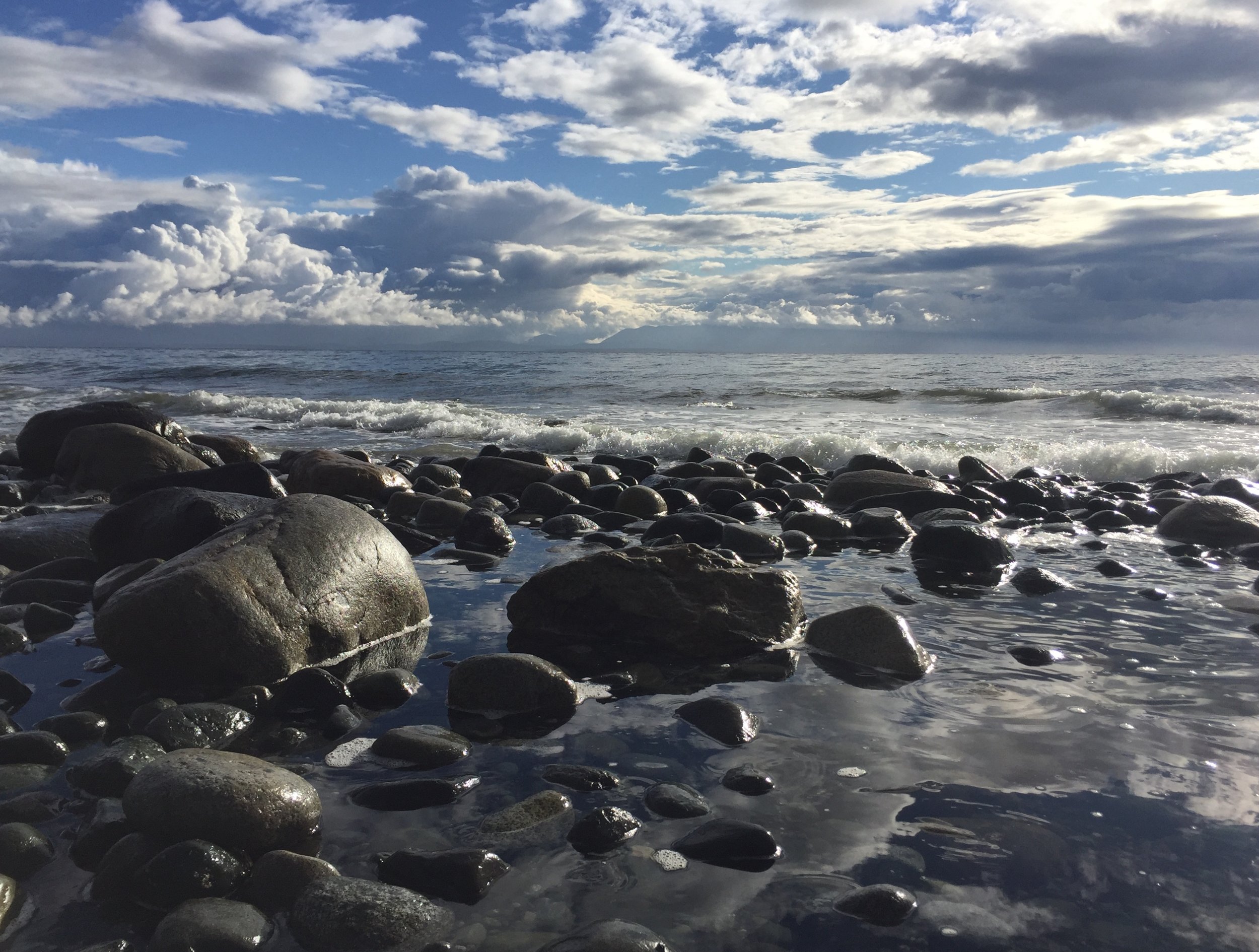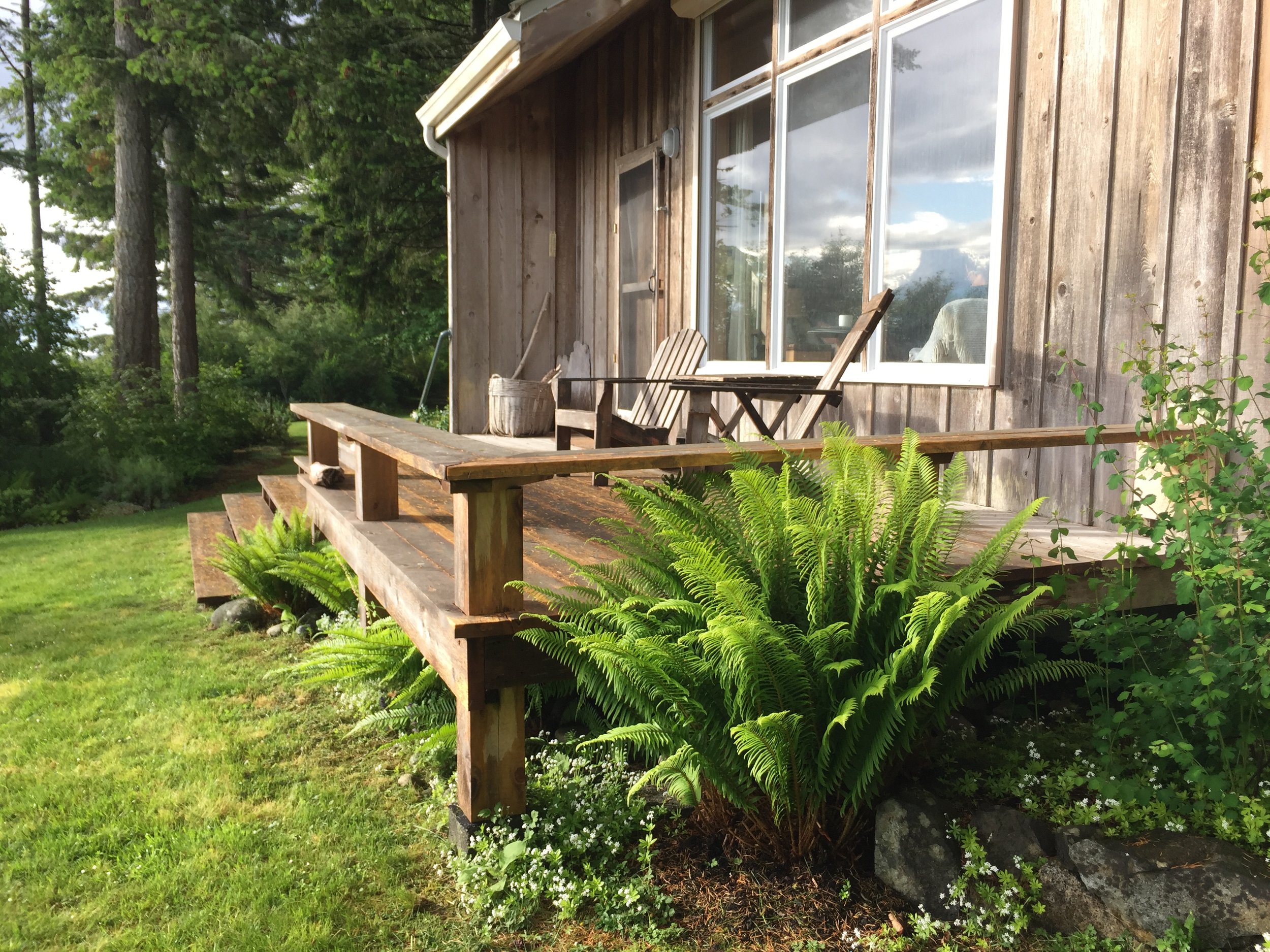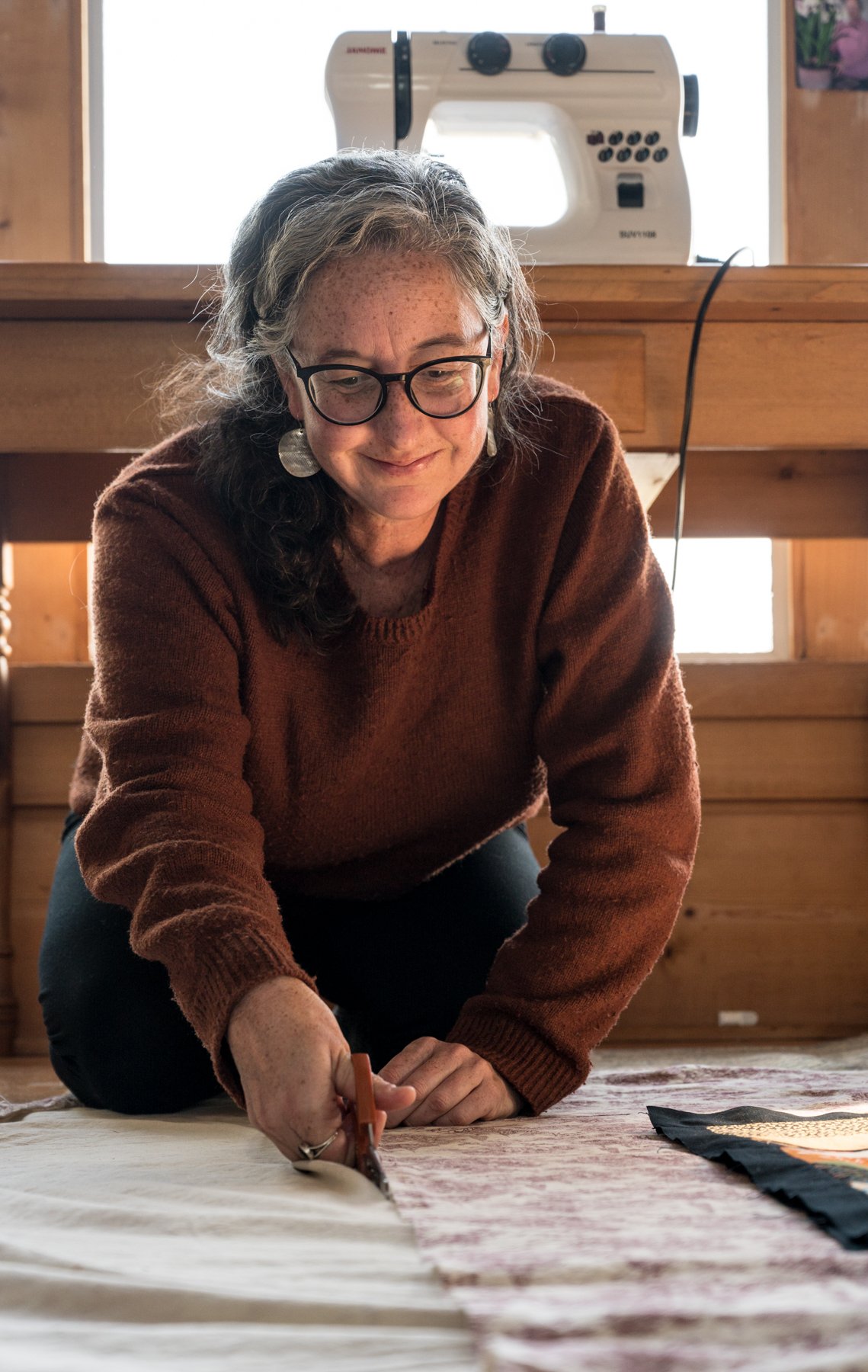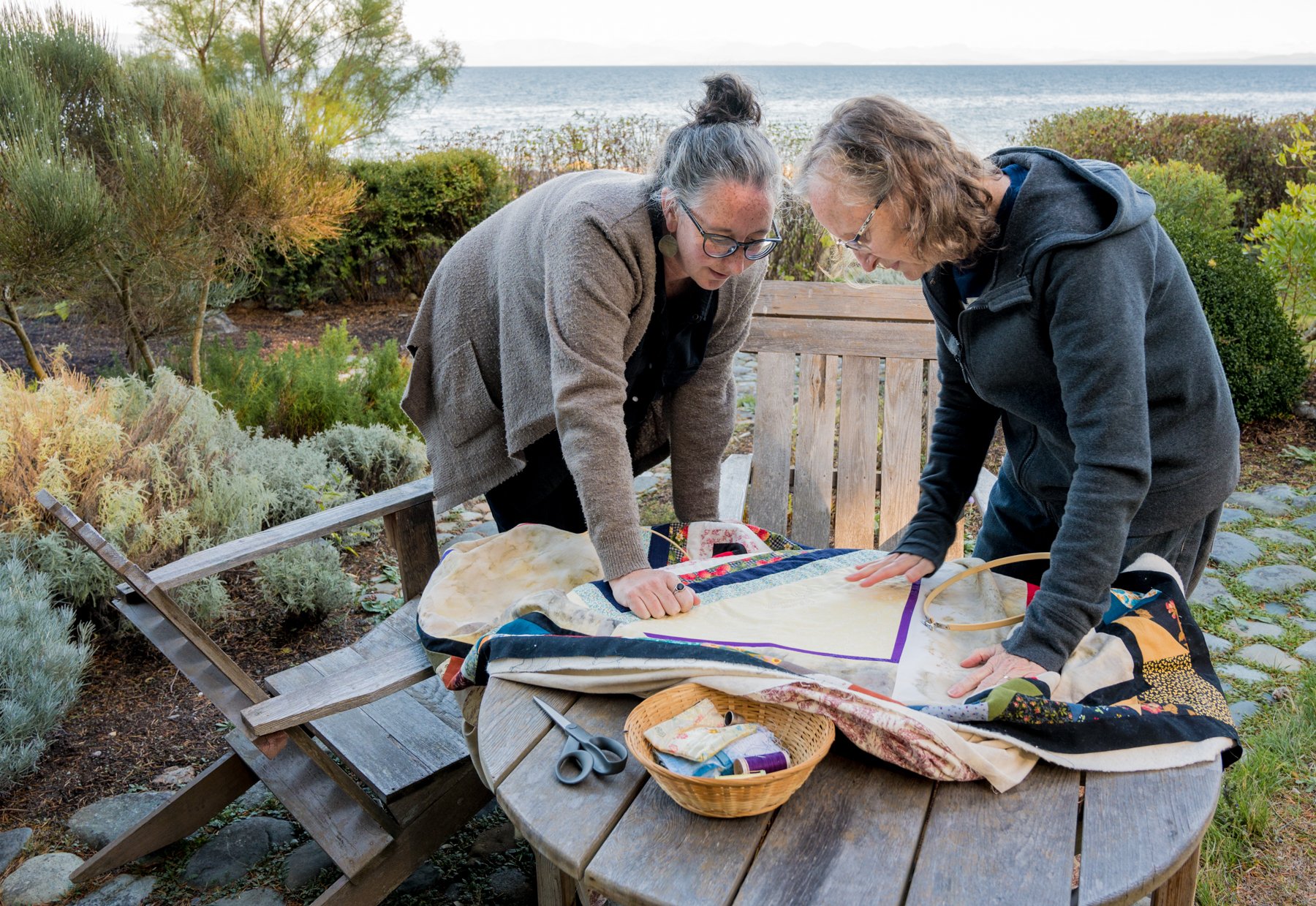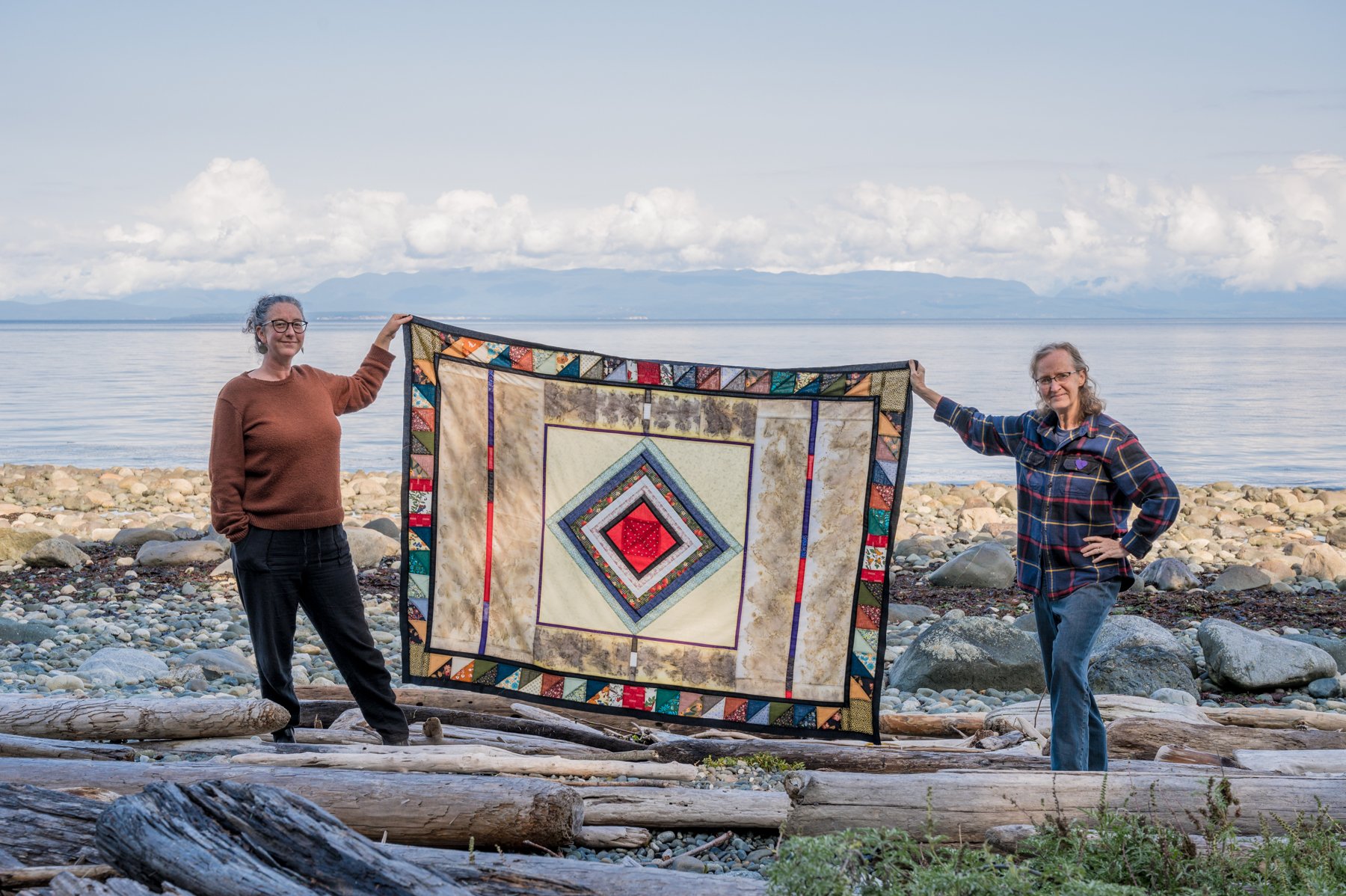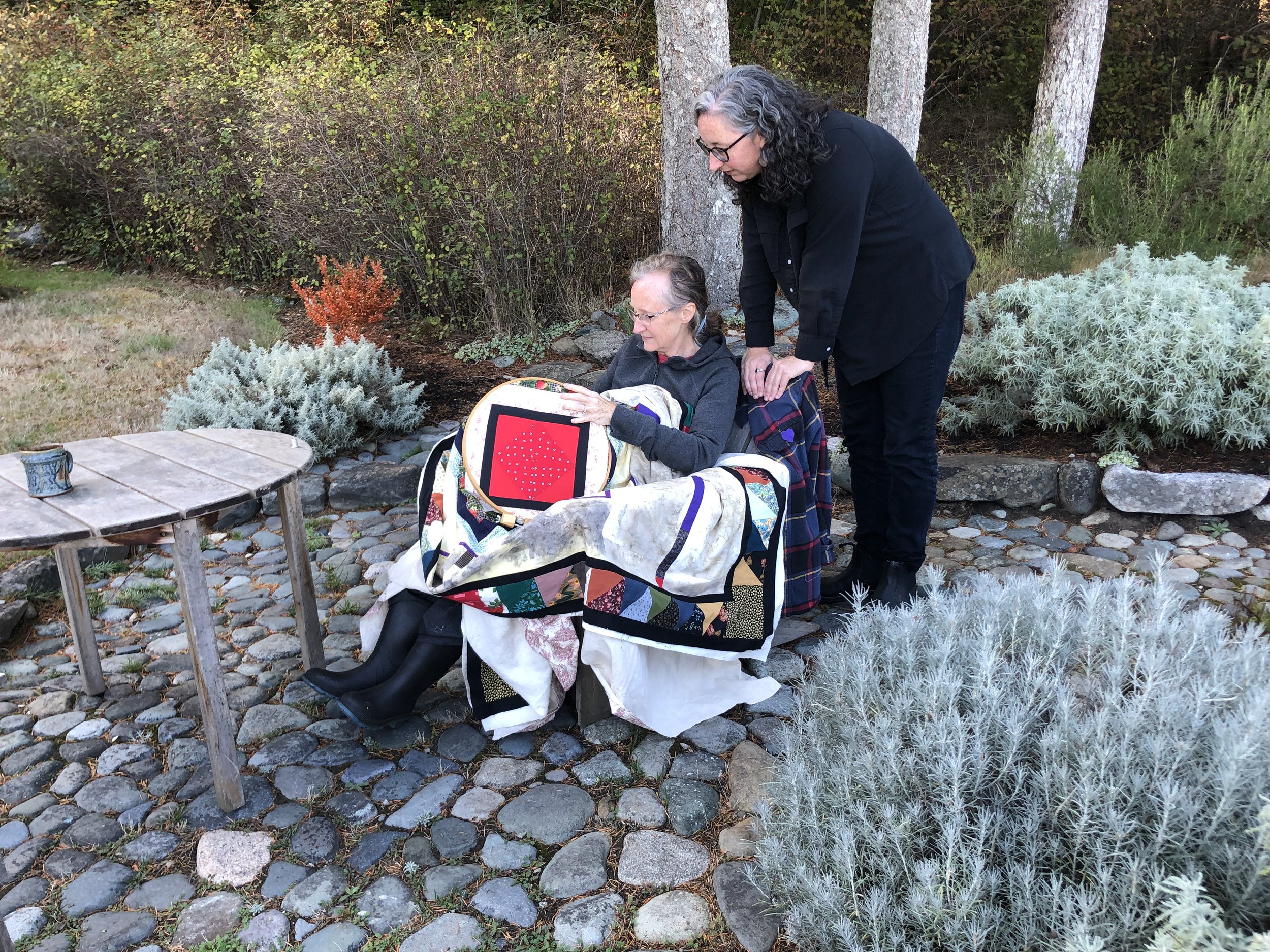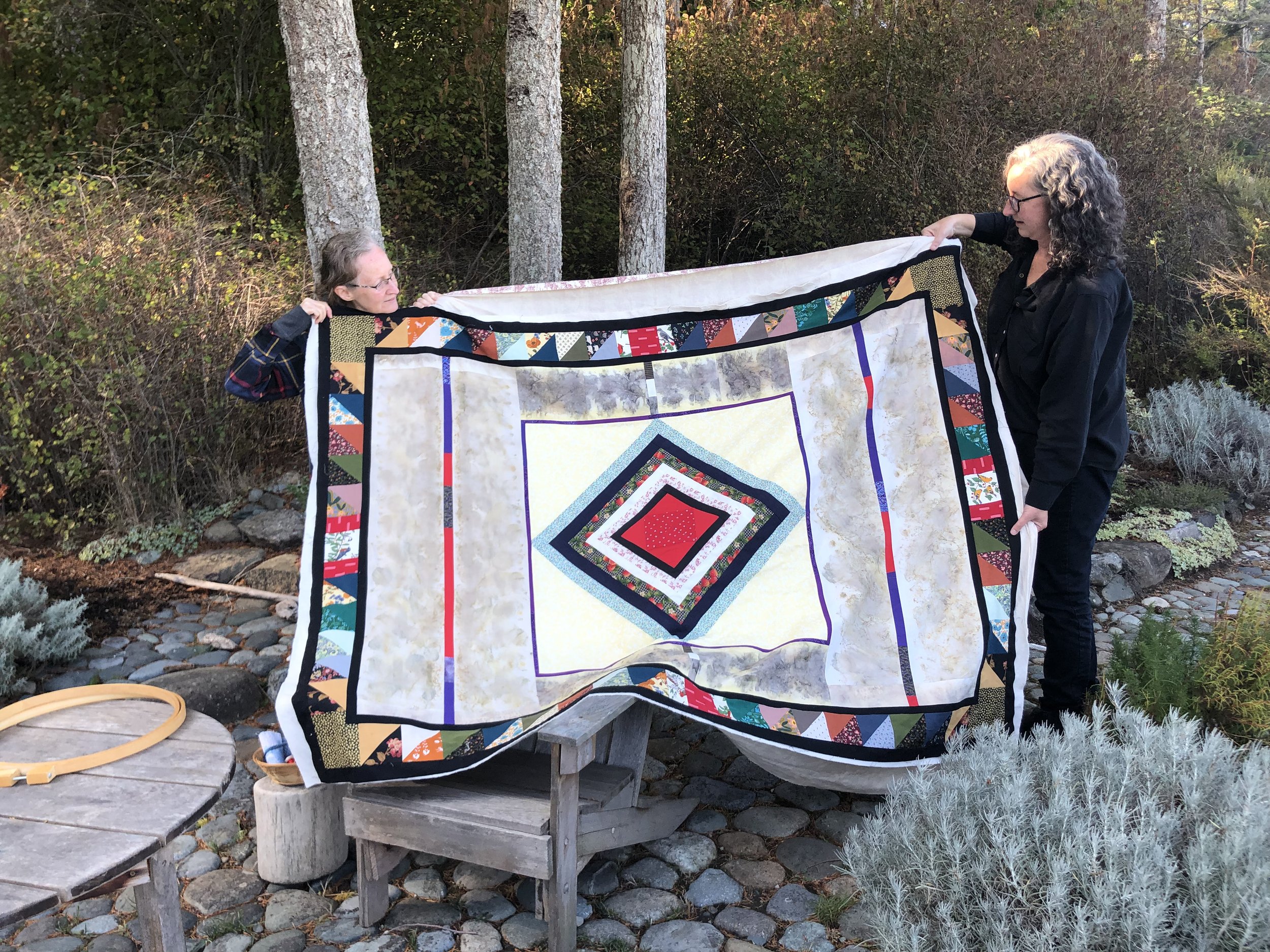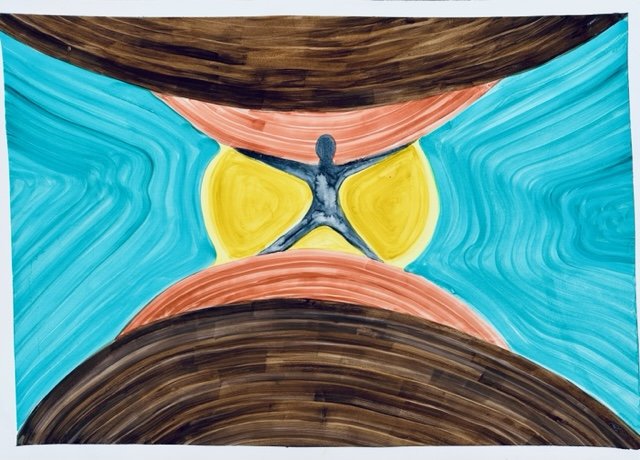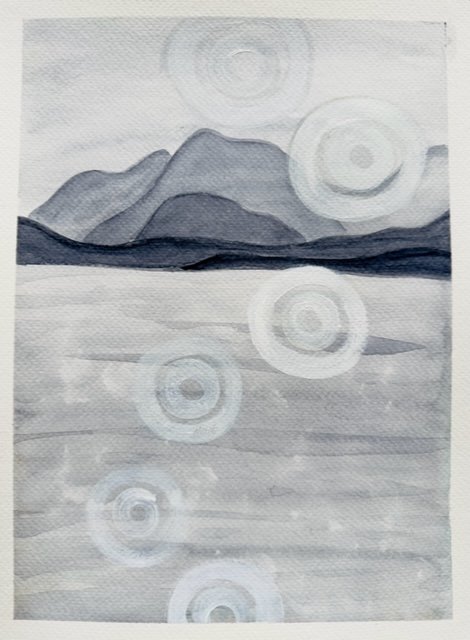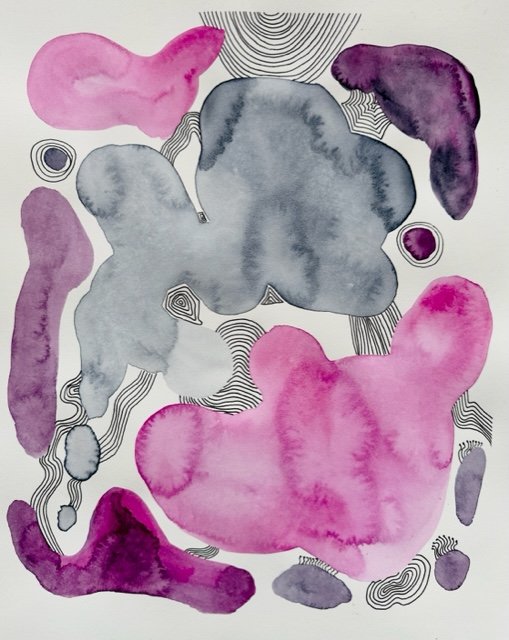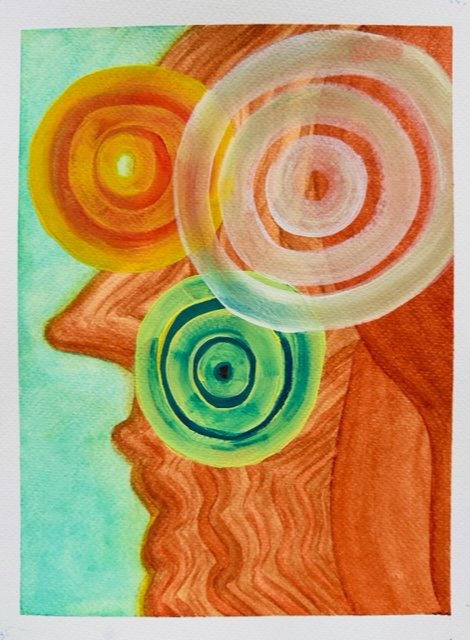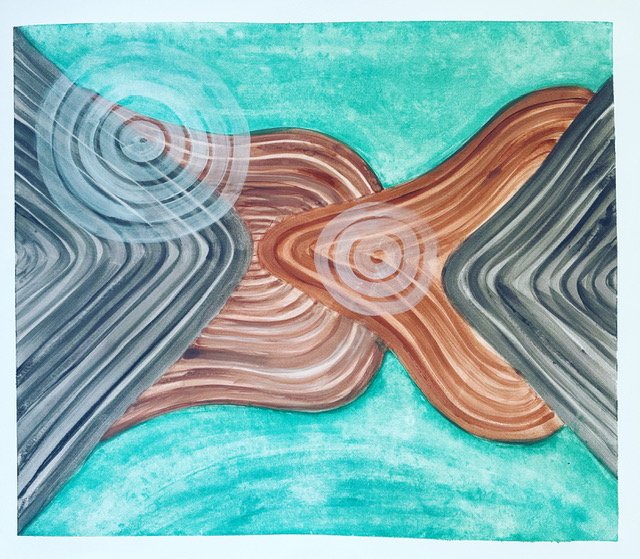What a year for creative expression!
In April, artist Holly Friesen arrived from Montreal, no doubt hoping for mild West Coast weather. In her reflections, Friesen writes: “The flocks of hellebores were the first to greet me as I descended the moss-carpeted driveway. Like small winged fairies they fluttered everywhere on this wondrous piece of land. They appear fragile but I watched them withstand torrential rain, fierce winds that topped an ancient fir tree, and even a morning of snow.”
“The wild diversity of weather kept me indoors, working by the fire more than I expected and it turned into a beautiful introspective and exploratory time. The charm of solitude is in how much more present one becomes to the non-human world…”
Tale Spinners Writing Group
Local writer Janet Miller was in residence in the last part of April. Fellow writers Kim Letson and Ian McIntyre joined her daily for critique sessions and writing.
Miller’s words speak to the healing power of the setting: “Quiet hours of writing and gazing at the view have really helped me in a personal way.” In her report, she writes: “Loons, seagulls, eagles, the dog-like heads of seals, a fish boat, and a tug with its container barge, are there to be seen on this late April morning. When I turn my gaze back to the work at hand, and re-enter the world my story, I find I have discovered the right beginning of my manuscript, and the right ending.”
Letson spent her time revisioning her book of walking adventures — Canterbury and Other Tales: Treading Ancient Trails. She may have some exciting news about this project to share soon!
Ian was also working on a piece of non-fiction: “In this tranquil, lovely setting that is already in the midst of spring blooming, I am tackling the story of my father as a motorcycle despatch rider in World War II as he trains in the United Kingdom and moves to the continent on D-Day plus thirty with the Canadian Corps Headquarters. The death and injury rate for despatch riders in all theatres was horrendously high, counted in terms of thousands and he managed to survive for the duration of the war and into the Occupation Force.”
Muriel Marc
Comox artist, Muriel Marc left her reflections in French: “C’est un rêve qui se réalise pour moi - un espace et du temps pour avancer sur mes projets artistiques. Et quel endroit! Une confortable cabane nichée au creux d’un merveilleux jardin. Le McLoughlin Garden restera à toujours gravé dans ma mémoire. Entre forêt et océan j’ai vécue une semaine au paradis où j’a pu laisser ma créativité et mon inspiration exploser: dessiner, graver, écrire, réfléchir, contempler, prier, marcher…et se sentir connecter à la nature si présente, si forte.” (Between forest and ocean, I experienced a week in paradise, where I was able to let my creativity explode: drawing, printmaking, writing, reflecting, contemplating, praying, walking and feeling myself connected to the strength and presence of nature..)
Jane Munro
Poet Jane Munro expressed her appreciation for the soundscape at the Gardens: “Living in the city with its river-roar of traffic—go somewhere, do something—such happiness this week to be here—my full self fully happy just to be here—reconnecting me with possibility, promise, and joy. A frog lingering legs wide, toes spread on bracken; the swoop of a raven; bumblebees attending tiny blossoms on a red current; a sea lion’s gruff snort. Even how the brown grass greens in patches after a few rain showers.”
Fabric Artist and Writer, Jessie Schut’s reflections on the creative process
The week before the retreat, friends had been asking me what I was planning to do. In my application, I’d stated that I wanted to spend time reworking my family story. I’d written about 100 pages but it didn’t feel right, and I knew I’d have to make changes. And I was also working on a large mural using fabrics, felted wool, and other fibre art techniques. I began compiling bins of papers and photos, art supplies, the tools for creating fibre art. They formed an imposing pile in the hallway by the door. These were the raw material I’d need to produce something meaningful, to have something to show at the end of the week.
And yet, these expectations could also be the undoing of me. I was feeling an uncomfortable resistance within me to spending a week with such goals. And so, instead of asking myself what I was planning to do, I asked myself a better question: why was I longing to take this retreat?
I had applied to this opportunity because I needed a time of solitude. Studies show the ability to tolerate alone time has been linked to increased happiness, better life satisfaction, and improved stress management. It also sparks creativity. I’d found all of these things to be true in past retreats. Perhaps solitude was all I would get out of this retreat, but it would be enough – enough to fuel more creative endeavors going forward, enough to get away from the incessant demands of everyday life and engage with bigger questions about meaning and values, enough to rest and be restored by nature’s beauty, to evaluate what was happening and what was important in my life.
And so I told my friends that I was planning to do nothing: nothing that smacked of goals and strategies, nothing that had a deadline, nothing that would create anxiety and pressure. Instead, I would be open to what came. I would be open to the creative spirit, to insights, to listening to my inner voice expressing its needs and desires. Spending time at McLoughlin Gardens would remove me from my everyday life and give me freedom to explore.
It was a great week!
This is what I wrote in my journal on my last day: “August 5: My last full day in this magical place. I feel sad and anxious about leaving – it’s just not long enough! And then I decide to turn that thought around: I feel deep gratitude for having had this experience – the deep peace I feel as I look out over the water, the time I took to reflect on my life, the insights I reaped because of that. May bit and pieces of this experience stay with me and bless me as I move forward.”
Ruby Singh
This year, for the first time, McLoughlin Gardens hosted a musician and composer. Ruby Singh is a Juno-nominated composer and the winner of a Western Canada Music Alliance award in Global Music. In his report he explains the art and technology of bio-sonification and includes links to several compositions.
Ruby Singh’s report from the field: ”In my time at the residency I was working on a couple of projects, kraKIN, a more-than-human hip-hop collaboration with Dr. Michael Datura , and a boom-bap menagerie of West Coast flora, fauna and fungi.”
In an age of ecological crisis, we created a multi-species assemblage aimed to decompose human dominion and reintegrate our minds with the resonant ecology of a living world. We were putting the final touches on a book that will accompany our place-based hip-hop album which incorporates both field recordings and “bio-sonification”—a technology that translates the bioelectric signature of flora, fauna and fungi into musical information. The other 1/2 of this book is an ambient and poetic offering, Polyphonic Garden Suite II, which intimately explores our relationship with this living, breathing and animate world. I created the album and accompanying poetry over the course of two years of travel to six biomes throughout so-called ‘british columbia’. I used field recordings, bio-sonifications, unique instrumentation and tempered keyboards with the songs of coastal wolves, orca, and birds (western screech owl, thrush, robin, song sparrow). To further deepen these sonic landscapes, the midi data of plants and fungi trigger the songs of their animal cohabitants: a Cottonwood tree triggers the call of the Song Sparrow that lives within its branches; bull kelp triggers the song of orcas. The time at the McLoughlin residency allowed the space and time to contemplate future iterations and writings for both these projects, while also providing a space for final editing and some image creation too.
Janis La Couvée
Poet Janis La Couvée wrote: “This studio residency has been a balm to my spirit, provided me with insight on how to structure and shape my poetry collection(s) which was my main goal. Sometimes answers come in a flash — this was the perfect place to foster that flash of inspiration - particularly on those liminal days when earth and sea, water and islands dissolve into one another and you feel as if you are living in a bubble—somehow completely apart, adrift in a world of your own but connected intimately to all of creation, the wonders of the planet.”
Vivian Vaillant
Writer Vivian Vaillant arrived at the Gardens with a children’s picture book project in mind. During her week, she met with her illustrator to talk about the characters in her story. In her reflections, she outlined eight steps for a successful writing retreat.
Step Seven: Bathe in the Flow State.
Vaillant noted in her journal the impact of the setting:
”I’ve never retreated to a place where books are so abundant. I suppose that is the difference between going it alone, and going alone together. This space feels special. From my flow state I feel somehow connected to the people that have been here before me. Iimagine the conversations that have happened through the years to make this place possible. Where might people have been sitting on the day they decided to gift this land? Who sat in on the very first meeting that decided to create a retreat space?”
Amy Crook
Fabric artist Amy Crook returned to the Gardens this fall, accompanied by her mother Veronica. Together they worked on an intergenerational quilt, the centre square of which is a square quilted by Amy’s grandmother.
Angelika Forray
Artist Angelika Forray came to the Gardens with an idea for how she would spend her time - exploring a particular concept:
“How Shapes Shape Us - We Are Not Separate From The Container We Are Contained In.”
She writes: “The first couple of days I spent exploring what shape means to me. Loosening up and trying to access what was inside me.”
She continues: “I did small studies and tried many different techniques. I then began to explore how the shapes are interconnected. Through exploring shapes I explore my own techniques, methods, practices and places of holding to discover what feels right. As I break out of my own restrictions and comforts into what I am to become- the shape that suits me best, now. ”
